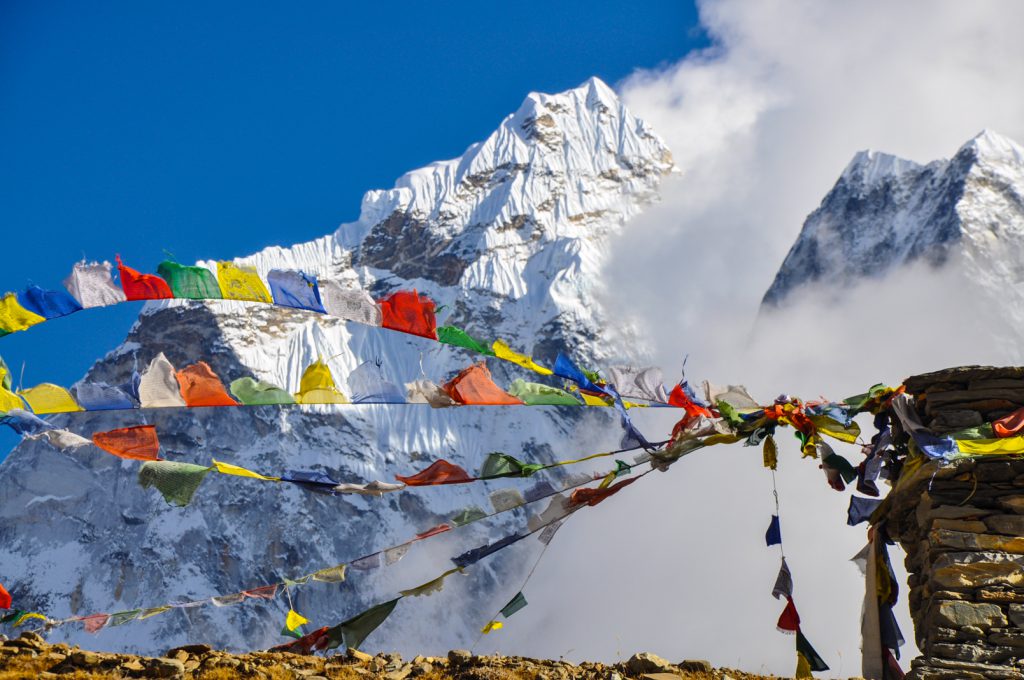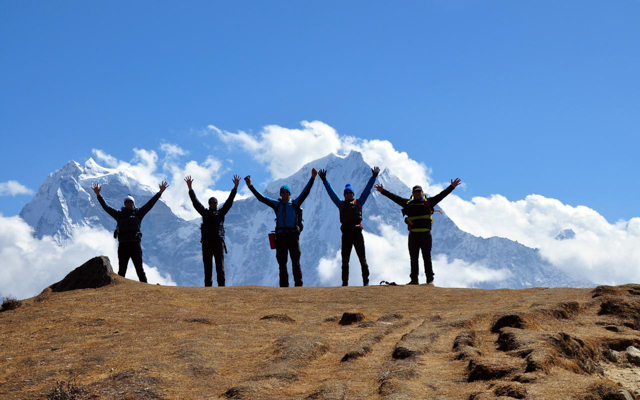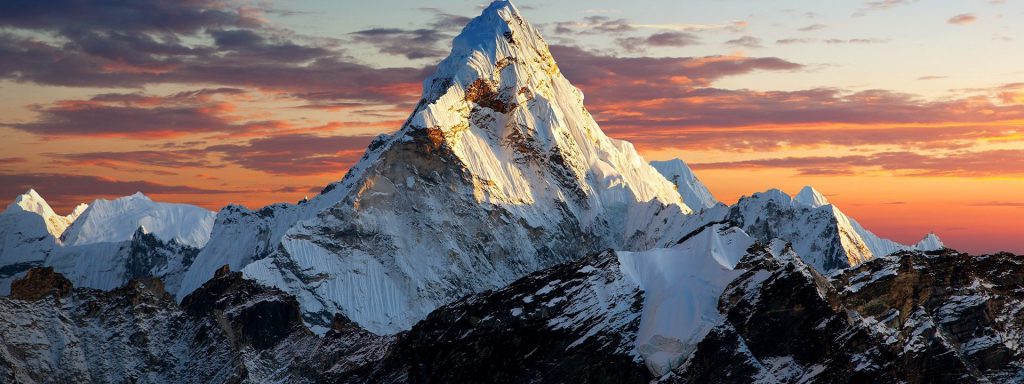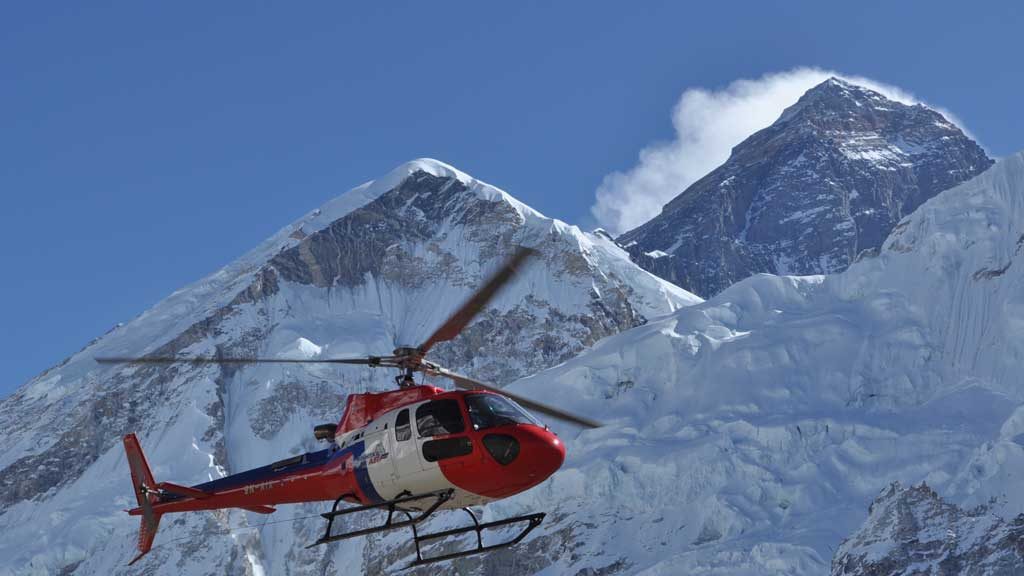Although luxury and adventure don’t sound to quite fit together,some people like to reward themselves after a hard day on the trail. The Everest Base Camp trek is the most classic in the world. Towering peaks, majestic vistas, deep gorges with crystal blue rushing rivers, pristine nature and the wonderful Sherpa people all go to make it a very memorable one. We stay in luxury lodges on a twin roomed basis with attached bathrooms for most of the journey then rough it for a day or two before returning back to Kathmandu by helicopter from Gorakshep, near Everest Base Camp. The trek is also suitable for people short on time but still, want to scale the base of the tallest mountain in the world. You may well be on honeymoon or celebrating an anniversary. We use five-star hotels in Kathmandu and luxury lodges in the mountains. Trekking all the way up to the Everest Base Camp and flying back to Kathmandu also has the bonus of not having to retrace your steps. An incredible mix of luxury and adventure!
Himalaya Heart provides total support to you all the way. Our mountain guides have spent many years leading groups at high altitude and are well able to deal with any problems. Our teams are always well prepared, we provide our porters and support staff with excellent equipment for travel into the mountains. Your trip leader will be paying careful attention to all clients and staff, making sure everyone stays as comfortable as possible and has the best chance of attaining their goals and completing the trip successfully.
Please note:
Delays with Lukla flights: These can happen any time of year, but are especially likely around monsoon season (late May to early Sept.). If your flight is delayed Himalaya Heart will reschedule you on the next possible flight. As conditions can change rapidly this may be very soon after your scheduled departure, or on very rare occasions be as much as a few days later – it is very difficult to predict. This can be pretty frustrating, but is simply part of the journey to the Everest region. We strongly recommend you add at least a day or two to the end of your trip if you have an international connecting flight to give yourself some flexibility in the case of any delays.
- Excellent acclimatisation, giving high success rates and greater enjoyment
- Trek to both Everest Base Camp and Kala Pattar
- Highly experienced Sherpa leaders, some of whom are Everest summiteers
- Four-star hotel, time to relax and a walking tour whilst in Kathmandu
- Full day visiting the heritage sites in Kathmandu
- Deeply rooted Buddhist culture
One of our team will welcome you at Kathmandu airport for the transfer to your hotel. The rest of the day is free to explore the bustle of Kathmandu.Overnight Hotel –
After breakfast at your hotel, your tour guide will pick you up for the Kathmandu city guided tour. Visiting UNESCO World Heritage sites. The historic Kathmandu Durbar Square is an ancient seat of Nepalese royalty and has beautiful carved architecture. PashupatiNath Temple a famous pilgrimage for Hindus and a major cremation site. on the holy Bagmati River. Visit two renowned places of Buddhist worship Swayambhunath is commonly known as the Monkey Temple site high on a hill before a visit to one of the largest stupas in Asia, BoudhaNath. Overnight Hotel –Kathmandu
We are up early for a 45 minute flight along the breathtaking white mountains and rolling green hills to reach the Tenzing-Hillary Airport at Lukla in Solukhumbu. What is one of the most stunning flights in the world culminates in a dramatic landing on a hillside surrounded by high mountains peaks. Upon arrival at Lukla, We are introduced to our Solu trek team who are based at our office there.After sorting ourselves we set off for the short trek to Phakding. An easy trail through Chaurikharka village and then descend towards Dudh Koshi until we reach Phakding. Phakding is located 8,700 feet above sea level. To assist in acclimatization, we only have a short hike today. However, if interested in additional activities we can take a side trip to a nearby monastery.
The trail today follows up the Dudh Koshi Valley, hiking through pine forest, crossing the river twice via small suspension bridges before reaching the village of Monjo. Monjo is the entrance gate of the Sagarmatha National Park. After entering the park there is a slight climb to Jhorsalle, the trail passes waterfalls with a lot of bio diversity on the way. We are rewarded with our first glimpse of Kusum Kanguru (6369m) Thamserku (6608m), Everest (8848m) and Nuptse (7879 m). A steep climb up to the beautiful large village of Namche Bazaar (3440m) a buzzing center of trade where many tradespeople come to haggle and sell their wares. Overnight Lodge.
We spend a day here allowing our systems to get used to the higher altitude. Set in a beautiful natural amphitheater, Namche Bazaar is one of the most attractive settlements in the Khumbu region. We take the opportunity to make short acclimatization treks up to Khumjung, a lovely Sherpa village above Namche and to The Everest View Hotel from where there are wonderful panoramic views of Everest, Ama Dablam, Thamserku, Nuptse, Lhotse, Tawche, and Kwangde .Plenty of time to pick up on the atmosphere Namche provides. Overnight Lodge.
We begin to feel that the real trek is now beginning although the start today is deceptive with a pleasant walk through the forest with magnificent views of the mountains. We follow an interesting path that traverses around the hillside high above the Dudh Kosi River. After walking for around an hour we arrive at Phungithanga. The trail climbs past some water-powered prayer wheels and then continues with a sustained climb through a forest of tall, mature rhododendrons that act as cover for musk deer and Himalayan tahr among the trees. Tengboche (3870m), is scattered across a wide, grassy saddle below a crescent-shaped ridge covered by scrub pines and firs. From the top of the hill, the mountains reveal themselves for what they truly are, the distinctive peaks of Amadablam (6856m) Everest (8848m), Nuptse (7861m), Lhotse (8501m) are both inspiring and humbling. We stop to visit the reknowned Buddhist Monastery at Tengboche, the largest in the Khumbu region. Overnight Lodge.
The early morning vista of mountains behind monasteries are spectacular from here. We leave Tengboche heading north to cross the Dudh Kosi river via a small suspension bridge which crosses the river valley. We continue on as far as Orsho to take the lower path along the west bank of the Imja Khola. Beautiful forest of birches conifers and rhododendrons. Continueing up the river we pass several chortens and mani walls strewn between small villages before reaching our overnight destination of Dingboche. Dingboche set amongst an array of fields enclosed by stone walls to protect the barley, buckwheat, and potatoes. acts as a gateway to several other treks towards Chukung and farther beyond towards Makalu. Overnight Lodge.
We spend an additional day and night here to aid the acclimatization process. There are optional hikes, a short hike 400 m to climb to Nangkartshang Gompa on the ridge north of Dingboche is a good one. Good views of Makalu (8463 m) from here. There is also the possibility for a day trek to Chhukung (4,730m) approx. 4/5 hours.To the north of Dingboche, there are spectacular views of Lhotse’s huge South Face. Oernight Lodge.
We begin with a descent to Pheriche village. It joins the trail below Thungla beautiful views of Cholatse across the valley. There follows another steep descent over the terminal moraine of Khumbu glacier. Today’s provides great views of the Mt.Tawache, Ama Dablam and to the north-Pokalde (5741m), Kongma-Tse (5820m) and the great wall of Nuptse. We carry on through a grassy valley rugged beauty at its best before reaching Lobuche a windswept collection of huts tucked in a narrow meadow between the glacier and the Lobuche peak. Tawoche and Nuptse are particularly strong from Lobuche towering just above. Overnight Lodge.
From Lobuche we follows the narrow gap between the glacial moraine and the mountain walls, we can make a detour to the edge of moraine to look over the Khumbu glacier. Wonderful views of Mt. Pumori, Nuptse, and other magnificent peaks on the way to reach Gorakshep which is the original location of the Everest Base Camp.The new camp is situated further up the valley.
After lunch we continue to Everest Base Camp Distance 3.5 km one way. The trail passes over rocky moraine and several small streams. At Base Camp we have the opportunity to experience the freezing and harsh conditions that mountaineers brave to summit this famous mountain. It is a place for climbers to gather to make the final preparations. We explore base camp and its surrounding glacier before our return back to Gorakshep. Overnight Lodge.
We are hoping for the normal sparkling and clear day as we set off early to climb Kalapathar ( around 2 km from Gorakshep. It is now you fully appreciate your effort is rewarded by an almost surreal experience of the 360-degree dramatic panoramic view of Mt Everest and the surrounding mountains of Mt. Pumori, Mt. Lingtren, Mt. Khumbetse, Mt. Nuptse, Mt. Lhotse, Mt. Ama Dablam, Mt. Thamserku along with many other peaks in the range. Spend some time to gather your thoughts before we leave for the easy walk for about 2hrs to Lobuche and onwards downhill to Pheriche. Continue down moraine to Dughla and then drop to the bridge over a gushing stream that flows out of the glacier. Overnight Lodge.
After a leisurely breakfast we board our Helicopter for the flight back to Kathmandu and transfer to our hotel.We often arrange a farewell meal on this day
Today it is time to move on,we hope you have enjoyed your time with us and we look forward to meeting up again. One of our team will be there to transfer you to the airport in time for your onward destination.
Cost Inluded
- Airport pick up and drop by private car.
- 3 * Hotel accommodation ( twin share) with Breakfast where stated.
- Government approved Trek team English speaking guide plus porters (all our staff are insured)
- Comprehensive First Aid Kit.
- Three meals a day plus tea/coffee (B.L.D.) on trek in lodges
- Private overland transport as described in the itinerary.
- Flight from Kathmandu to Lukla / Chartered Helicopter Gorakshep to Kathmandu.
- All conservation and trek permits (T.I.M.S.) for the region you are trekking in.
- Sightseeing if mentioned in the itinerary.
- Assistance with buying trek gear or we can loan you for the trek.
Cost Not Included
- International flight fare and travel insurance
- Meals in Kathmandu
- Alcohol and any drinks on the trip (Except 3 cups of tea a day during the trek)
- Tips for guide and porters
- All expenses of a personal nature e.g. toilet paper, medicines, and confectionery etc.
- Any other cost raised by unforeseen circumstances
Everest Base Camp Luxury Lodge and Helicopter Trek FAQ
You can bring your sleeping bag from home or you can rent one in Kathmandu or Himalaya Heart will loan you one. Most tea houses also have blankets but we suggest you bring a warm bag with a liner to use with the blankets.
Yes. All of the necessary permits and conservation fees for your trek are included in the price and will be arranged for you by Himalaya Heart prior to your trek. (we prefer doing this on line before your arrival) For certain restricted regions (like Manaslu and Upper Mustang) we need to have a full day in Kathmandu prior to your trek as we need your passport for the permit registration.
We have fixed departures clearly stated in the website otherwise if you are planning to make your tour specific to you and your group the tour starts on the date that works best for you.Typically, you need 2 days in Kathmandu prior to your trek.
You can leave your additional luggage at your hotel in Kathmandu or at our company office in Thamel. Either way, your luggage will be waiting for you at your hotel when you return back from your trek
You can buy virtually everything you need for trekking from down jackets to water bottles in Kathmandu. There is a variety of branded stores as well as a large selection of copied products mainly in Thamel that are of fairly good quality. It’s still worth bringing your own gear if it doesn’t take up too much weight, especially your own trekking boots to avoid any potential issues when purchasing new shoes..
You should bring trekking boots that are comfortable and broken in. There can be some snow at higher altitudes especially when crossing high passes, so it’s good to be prepared for a variety of conditions. Your footwear should be strong and durable. It should have a chunky sole—preferably made of Vibram or another durable material—and should also protect your ankles..
Tipping is not required but is expected, and really depends on how happy you were with the service. Guides (both for trekking and cultural tours), porters, and drivers are typically provided with a tip at the end of their service with you..
Most days in the mountains involve 4-6 hours and longer of trekking. When you consider your day starts at 8 am and ends around 4-5 pm, it’s not too arduous as you’ll be taking a number of breaks and stopping for lunch along the way. The higher you get in elevation (especially in the Everest region), the shorter your trekking days will get to ensure we minimize the risk of altitude sickness.
You only need to carry your day pack with daily essentials (sunblock, water, hat, light jacket, and camera) Our porters carry the bulk of your gear, such as extra clothing and overnight essentials
All of our guides at Himalaya Heart speak English and have had many years of experience in guiding foreign travelers. It’s a requirement that they all are trained in first aid as well and we carry a first aid kit during the trek.
For group treks (treks that start on a specific date and are open for travelers to join), the group size can range from 2-10 people but typically ends up being around 4-6 people.
If you fall ill during your trek, the course of action depends on what’s wrong. If it’s altitude sickness, moving to lower altitudes and taking altitude medication will solve this in most cases; if it’s severe, our guide will arrange for an emergency evacuation by helicopter Himalayan Heart will cover the initial costs then claim from your insurer (be sure that emergency helicopter rescue is covered in your travel insurance it is an essential requirement before travelling with us). If you have stomach sickness or another type of food or water-related illness, our guide will have medication on-hand for most common illnesses.
When’s the best time to visit Nepal?
The main seasons for trekking are the spring (Mar to May) and autumn (Sep to Nov) when you’ll have clear skies and superb mountain views. The winter (Dec to Feb) is also a great time to visit— these months offer a unique experience and fewer crowds but lower altitude treks are better at this time of year as its cold at night.
What’s it like during the monsoon season?
(Jun to Aug), Most of Nepal experiences heavy rain for a few hours each day. It’s humid, wet, and the trails in the lower regions (Ghorepani, Ghandruk, Langtang, etc) can be quite muddy. If you don’t mind the rain you’ll have the trails to yourself, the skies often clear up in the morning, and certain treks offer stone-paved trails that drain the rain and make for easy trekking. Also, certain regions, like Mustang and the upper reaches of Everest, lie in the rainshadow of the Himalaya and receive little rain but views however are still likely to be restricted.
What is Altitude Sickness?
Many sites on Google speak about 2.500 meters as when problems may arise. In our experience this is misleading you may feel a slight headache but rarely anything more that a painkiller won’t relieve. If we are talking about the possibility of contracting a more severe form of altitude sickness it is going to happen over 4.000 meters and once again rare and easily resolved by descending to a lower altitude. Altitude sickness describes several symptoms that happen to your body when you’re exposed to a higher elevation within a short period of time. When people are traveling or either climbing to a higher elevation quickly. The higher you climb, the lower the air pressure and oxygen levels get. Our bodies can handle the shift, but they need time to gradually adjust. Himalaya Heart carefully designs treks to minimise any risk.
What’s the difference between private and group tours?
Private tours are tailor-made itineraries built by us around your travel dates and personal interests, whereas group trips are pre-packaged and depart on specific dates. Group trips are also open for others to join, whereas private trips are just for you. You will find a list of fixed departure dates on our website.
How do I get my visa for Nepal?
For most nationalities visa can be obtained on arrival in Kathmandu. It takes around 45 minutes and is the most convenient way to get your visa you will need passport size photos.. You can also apply for a visa in advance from a local Nepali consulate in your country if you’d like to have everything arranged in advance. Cost15 Days – 25 USD / 30 Days – 40 USD / 90 Days – 100 USD
How much luggage can I take on domestic flights?
For mountain flights, you’re allowed 5 kg. carry-on to the plane and 10 kg. for checked-in luggage. For non-mountain sector flights, the check-in allowance increases to 20-25 kg.
Are hotels included in the tour price?
Himalaya Heart organises complete tours, meaning everything is taken care of from the moment you arrive in Nepal to the moment you leave, including all of your accommodation in a three star Hotel. If you require better accommodation please let us know and we can arrange this and adjust the tour cost accordingly. Each of our tour pages shows clearly what is and what is not included in the tour price.
Are there any extra expenses not included in my tour price?
Personal expenses (tips, soft drinks, bar bills, laundry, telephone calls, donations, and extra snacks, etc) are not included in your tour price. When checking a particular trek page on our website we have clearly stated what is and what is not included. If you’re going trekking, the only things you’ll need to pay for out of pocket are wifi and battery charging (when available), extra meals outside of what’s included, alcohol, and soft drinks and perhaps hot

 +977 9851093973 (Thakur)
+977 9851093973 (Thakur)



